
.
Industry - Shipbuilding near Front Street (1) : Robertson, Allen, McMaster, Co-operative
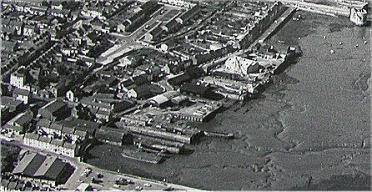
Private shipbuilding slipways, sheds and cranes, c. 1970. Gordon
Street is in the foreground, with Front Street and the Gun Tower
in the background.
Pembroke Dock's first major private shipbuilding works developed in area along the shore
from Front Street to Gordon Street - along with the timber business, in early days closely
linked to shipbuilding.
Mr William Robertson's career began in the 1830s. He moved into private business from
the Dockyard where he had been a clerk. He "built several small craft" including the
barques Resolution and Cambria "and worked up an excellent timber trade", with "two
large sawpits" on the site later occupied by Robinson's timber yard and saw mills.
Mr Richard Allen from the 1850s constructed ships first on his own account, then in
partnership at various times with Mr James Warlow, Mr Long, and his son Mr S.R. Allen -
who directed the business after his father's death in 1873. Ships built, as listed by Mrs
Peters, included:
Arethusa, for Capt. Pring of Brixham
Carmarthenshire, owned by David Jenkins & Co., London, was the first merchant ship to
enter Yokohama harbour.
Wave, a steamer used for local market day traffic
Richard Allen & Son were also " contractors to the Trinity Brethren for the repairing of
lightships ... and also to the Admiralty, for whom they built and equipped a sailing vessel
for trading between the various yards".
Two other enterprises operated, in this area. Around 1860, Messrs McMaster "built a few ships", including Katherine Jane, a brigante and Monte Bello, a barque.
Their yard then developed into a timber store for the company's sawmills. The Pembroke Dock Co-operative Shipbuilding Company was in business from 1873-9,
employing nearly a hundred men. McMasters returned briefly to shipbuilding to complete the co-operative company's last, unfinished, vessel. She was launched
in 1881 as Mary McMaster.
(Sources: Hogg, Lost PD; Mason 93; Peters 51-5)
Picture by courtesy of Pembroke Dock Museum Trust (Richard Hayes Marine Archive).
Industry - Shipbuilding near Front Street (2) : Francis, Hancock
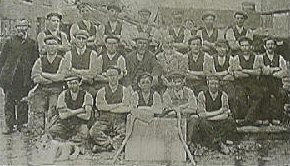
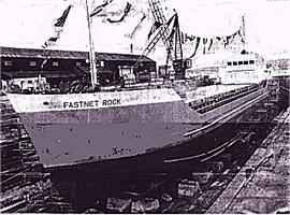
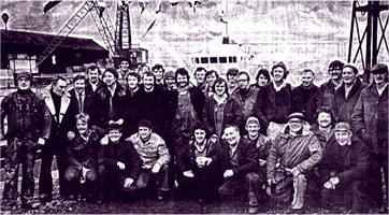
J. & W. Francis, shipbuilders of Milford, operated from 1888 in Pembroke Dock. Like
the Royal Dockyard, a number of Pembroke Dock's private shipbuilding ventures had
started in Milford. A manuscript lists the following ships built by Francis, with further
details of each:
Pioneer, ketch, c.1896
Enid, ketch, c.1899
Advance, schooner, c1893
G.S. Dickman recounts the early story of P. Hancock, shipbuilders. The company moved from Milford to Pembroke Dock around 1920, building fishing
smacks including the Arravale. Hancock's built more than a dozen small ships for the Admiralty during World War II. Later, Hancock's built the new
ferryboats Cleddau King and Cleddau Queen, and continued until c. 1979.
(Sources: Peters 54-5; Pem RO HDX 1321/1; Dickman; Turnbull)
Pictures by courtesy of: Francis shipwrights, Pembrokeshire Record Office - Fastnet Rock & shipwrights, Western Telegraph (photographer Mr Alf Williams).

Shipwrights at J. & W. Francis, Front Street, 1907
Fastnet Rock (1979), the last ship built at Hancock's
.... and the men who built her.
Industry
- Private shipbuilding & industry in the Dockyard : Wards, Hayes
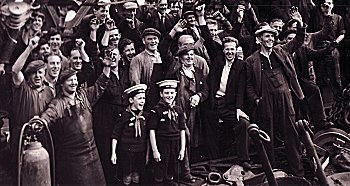

Celebrating the completion of ...Ocean Layer
In the 1930s Wards of Milford dismantled ships in part of the old Dockyard.
After World War II the Richard Hayes group of companies continued
marine engineering there. One memorable project, in the 1950s, was the
conversion of the cable ship Ocean Layer. As the Haven's oil industry
developed, Hayes companies provided marine and engineering services for
the tankers and refineries
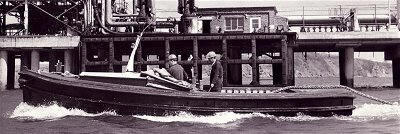
Berthing an oil tanker: a Hayes rope-runner tows the tanker's
line from ship to jetty
Sources: Scott, Soldier who became legend...; PDMT RIchard Hayes archive)
Pictures by courtesy of Pembroke Dock Museum Trust (Richard Hayes Marine Archive) & Mr Douglas Hardy (photographer):

Industry
- Light industry after 1945
After World War II, an an industrial estate developed at Kingswood - The Pembroke Woollens
Company operated next to Davies Steel, whose products included roller skates. Today, traditional
and newer industries continue to operate in the Dockyard, in the Kingswood area, and elsewhere.
Heavy industry after 1945: Oil, construction & power station
In the 1960s and 70s, the oil industry became a major source of employment in Pembrokeshire, with
the BP jetty, and the Esso, Texaco, Gulf and Amoco refineries. These brought work on a series of
construction projects, and jobs on the completed refineries. BP, Esso and Gulf subsequently closed,
however.
Pembroke Power Station, closer to Pembroke Dock, also brought construction work in the late 1960s
and offered permanent employment until the 1990s.
In the early 1990s, the proposal to burn orimulsion fuel aroused passionate debate. Environmentalists argued this would threaten health and nature,
while National Power maintained the fuel was safe and economical, and would keep jobs. Heavy pollution, after the tanker "Sea Empress" ran aground,
added to environmental concerns. The scheme was abandoned, and the power station closed and partially dismantled.
A century before, the environmental impact of development had been dismissed rather more brusquely. In 1897, Llangwm fishermen objected that
Pembroke Dock's new sewerage system would destroy the oyster beds at Pennar mouth - "the choicest oysters are to be had at Crow Pool". The inspector
showed scant sympathy - "I don't want to hear about the choicest oysters". (laughter) "I want to know about sewerage".
Similar debate surrounded the nearby LPG project, which is now under way.
Tourist industry
Pembroke Dock is one of Pembrokeshire's newer tourist attractions, with its restored historic buildings and its museum. Today's visitors follow the
footsteps of tourists a century ago, when holidaymakers at Tenby were advised not to miss a trip to the nearby shipyard, "deserving of the most
attentive and careful inspection".
Dockyard policemen would give guided tours, showing the machines in operation - "The steam engines should be visited ... the Nasmyth hammer in full
operation, the huge furnaces, bellows, iron beams ... the huge anchors and chains, too, will astonish". Beatrix Potter was duly impressed, although she
noted that with 3000 men working on "thousands of iron rivets, the noise was deafening". A visit to the same site today is slightly less dramatic, but
considerably quieter.
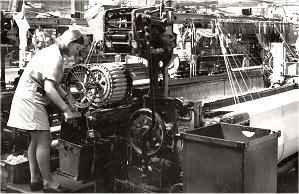
(Sources: Gwynne, 45-6; Potter; PT 22 Jul 1897)
Picture by courtesy of Pembrokeshire County Council Museum Service.

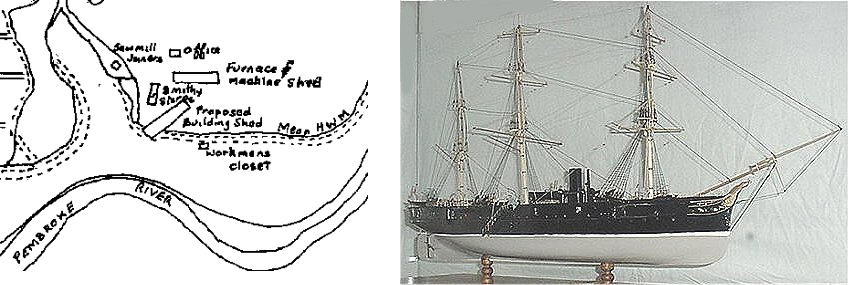
Tales of a little Japanese warship called Hiei (which translates as "Sacred Mountain") pop up from time to time and so, being local and having an interest in
the Maritime Heritage of this area I have spent some time in researching the ship and have completed a scale model of her. The story began when Edward J
Reed (later Sir Edward),former Chief Constructor of the Royal Navy had political ambitions, and decided to stand as the Conservative candidate for Pembroke
Boroughs. He promised, if elected, that he would build a private shipyard in Pennar, Pembroke Dock offering to employ many of the workers recently made
redundant from the nearby Royal Dockyard. His opponents vociferously protested, but the incentive offered persuaded sufficient people to vote for him and
he was returned to Westminster with a majority of 29 on February 1874.
True to his word he opened a shipyard in Jacob's Pill, Pennar, Pembroke Dock and set up the Milford Haven Shipbuilding and Engineering Company. (Pill is local
dialect for a small tidal inlet; this one owes its name to Jacob Jenkins who once lived in the vicinity). Just 19 months after his election the keel of Hiei (the
press of the day spelt it Hi Yei) was laid down. She was originally barque rigged and built entirely of iron and was launched on 19 June 1877 and was one of
the Kongo class of armoured corvettes. Sir Edward was a prolific warship designer and is reputed to have designed the Royal Yacht Osborne, launched
Pembroke Dockyard on 12 December 1870.Ships built to his designs appeared in the Russian, Turkish and Greek Navies as well as the Japanese Navy. He also
tried to make the new fangled technologies relating to iron ships propelled by steam into a science. At the time it was very much a case of “let's build it and
see what happens scenario” often with disastrous results such as the capsize and sinking of HMS Captain off Cape Finnisterre in the Bay of Biscay in a gale,
due entirely to serious design errors.
The disaster was observed from the bridge of HMS Inconstant, a composite frigate of sixteen guns which was also built in Pembroke Dockyard in 1868, and
was despatched on September 8, 1870, with the official news of the disaster to the Admiralty.
HMS Captain was not one of Sir Edward Reed’s designs and he had predicted, by calculation, her instability. Such was the strength of his feelings about the
poor design and the “let's build it and see ” attitude of the Admiralty that he resigned from his position as Chief Constructor of the Navy before the disaster.
One other ship of this class was built, the Kongo, whose keel was laid at the same time by Earl's Shipbuilding Company of Hull. The third ship (of a different
class) to be built in Britain for the embryonic Imperial Japanese Navy was the Fuso but she too was built elsewhere.
Incidentally, Japanese Naval Cadets were trained at the Royal Naval College in Greenwich until 1911. Even during World War 2, Officers still wore British Style
Uniforms
Hiei design was based on the British Gem and the Russian General Admiral classes of corvettes (both of which were designed by Sir Edward Reed) and was
originally barque rigged although this was changed during a refit in 1895. Both Hiei and Kongo displaced 2200 tons and were propelled by steam plants
delivering 2,500 ihp, which gave them a top speed of 14 Knots. Hiei was fitted with Krupp breech loading 150 mm and 175 mm guns and several four and five
barrelled Nordenfelt machine guns. She had 308 Crew.
At the time Japan was recovering from the Satsuma Civil War and ,seeking to build a modem navy, came to Britain to fulfil this ambition. The Japanese
Admiralty sent a young Lieutenant, Hechahiro Togo, to oversee the construction of the Vessel in Pembroke Dock.
He later became a National Hero and a driving force behind the creation of the Japanese Navy eventually becoming Commander in Chief of the Japanese
Grand Fleet and the founder of the Imperial Japanese Navy.
During this time he severely damaged the Chinese fleet at the battle of Yalu in September 1894, and destroyed the Russian Pacific Fleet while in harbour at
Port Arthur, 1904 in a surprise attack, declaring war on the following day. The Russian Baltic Fleet was despatched to become the Second Pacific Fleet under
Admiral Rostesventsky to meet this threat in 1905.The poorly organised , but numerically superior, fleet was met by the Japanese in the straights of Tsusima
which lie between Japan and Korea. The ensuing one-sided battle led to the catastrophic defeat of the Russians. Admiral Togo entered Tokyo on October 21
1904, the centenary of the death at the battle of Trafalgar of the British Admiral Lord Nelson, upon whom Admiral Togo had modeled the Japanese Navy.
One of his duties was the education of the late Emperor Hirohito, and on the death of that emperor's father he committed Junshie (a form of ritual suicide)
Returning to Pembroke Dock, the launch of Hiei on 9 June 1877 attracted many dignitaries of the time and created great interest and excitement among the
population of Pembroke and Pembroke Dock. His Excellency Jushie Wooyeno Kagenori , Envoy Extraordinary and Minister Plenipotentiary of his Imperial
Majesty the Mikado of Japan and Members of the Japanese Embassy attended, together with Prince Hachisuka ,Former Ministers ,Embassy Senior
Staff,including the Consul General. Also attending were the British Admiral the Right Honourable Lord Clarence Paget, Chairman at the time of the Milford
Haven Shipbuilding and Engineering Company and his Board of Directors, Pembroke Dock Mayor and numerous others. Mr. Reed's guests at a banquet in
London were Dr and Mrs Schliemann (Discoverer of Troy) and Baron Reuter (Founder of the Newsagency)
Celebrations began when the Japanese Ambassador and his party arrived by rail into the Royal Dockyard where they were wined and dined by the Captain
Superintendent of the Dockyard. The Ambassador was presented to the Mayor of Pembroke Dock at Hobbs Point at 3.00pm and then proceeded on a
serpentine tour of Pembroke Dock.
While proceeding along Bush Street, the procession arrived at the house of Mr. H A Jones– loyd , a solicitor ,where a pleasing and novel reception awaited the
ambassador .A beautiful arch had been erected and upon a dais six or seven young girls in traditional Welsh costume presented an address of welcome to
Lady Wooyeno.
A pause at the Barrack Hill followed, to hear a song of welcome sung by local schoolchildren, then the party went up the hill to the site of the new Bethany
Baptist Chapel in High Street where Miss Rose Reed (Sir Edward's Daughter) laid one of the foundation stones, after which another choir sang the Hallelujah
Chorus .
At the corner of Hill Street, Bufferland, another arch had been erected over the street. This was surmounted by a dragon made of wild iris leaves, a plant
which abounded in the nearby marshy areas. It served equally well as it represented the dragon of Wales , though its colour was green and not red, while it
served as a delicate compliment to the Ambassador and attendants by symbolizing the allegoric emblem of the East.
Eventually the Procession eventually reached Lower Pennar at 5.30 p.m. in time for the 6.00pm launch
After the successful launch the Ambassador and his party attended a banquet after which there was a grand general illumination consisting of thousands of
Japanese lanterns, balloons, peacocks and giraffes. The banquet was held in the Victoria Hotel, situated at the top of Pembroke Street, Pembroke Dock, and
quite the most opulent hotel in the town.. Eventually the Ambassador and his party were taken to Pembroke Dock railway station when the Japanese National
Anthem was played prior to their departure for London.
Hiei played a major role in the Naval engagements which saw the rise of Japanese Naval Power. The most notable of these was the Battle of Yalu on 17
September 1894, during which she was severely damaged by Chinese battleships. Casualties were 20 dead and 34 injured. She was repaired and removed
from the operational fleet but she was be used as a coast defence and survey vessel until sold in 1911.
In 1909 a British Marine Engineer called Graves (a native of Porthmadog in North Wales) was on honeymoon in Japan. At the same time an American warship
was paying a courtesy visit to the country. Unfortunately the visit was prolonged by the fact that the ship had broken down and the Americans were too
embarrassed to ask for assistance and the Japanese were too polite to show they knew something was wrong
Thus the arrival of an experienced engineer was a godsend to the Americans and they secretly invited him aboard to get them back to sea again, which he
was able to do. During their prolonged stay in Japan the crew made many lady friends and when the ship left these ladies were very tearful. According to one
story, the composer Puccini heard the tale and used it as his inspiration for the opera Madam Butterfly,
The Japanese were aware of the help the British engineer had given to the Americans and as soon as their ship had sailed he was invited to assist them repair
a Japanese ship. He stepped aboard and to his surprise he saw she was none other than Hiei built in Pembroke Dock! Again he was able to direct repairs and
get her back to sea. 1 am afraid there is no record of his bride's feelings about all this activity on her honeymoon.
1 understand that a later Hiei took part in the Pearl Harbour attack in World War ll, and today a smaller vessel of the same name is part of the Coast
Protection Force of Japan, so the name lives on.
In the garden of the Master Shipwright's House in the old Royal Dockyard, Pembroke Dock a Japanese Ginko (or maiden hair tree ) grows. Local tradition has
it that the tree was given by the Japanese officer who lodged there while his ship was being built , as mark of his gratitude. Could he have been the then Lt.
Togo?.
The Jacob's Pill Yard seems to have had mixed fortunes after the glory days There was a lull between 1877 and 1882. Work may have been done during this
time but I can find no record of it. 1882 saw the construction of the Rheubina, an iron hulled screw and sail ship of 737 tons. The following year the
Rhiwderin, 988 tons of similar construction was built, both for John Cory and Sons of Cardiff .
One Royal Navy ship, H.M.S. Acorn, was laid down 6 October 1882, launched 9 June 1884, completed June 1886 and commissioned 22 Feb. 1887. She was a
970 ton composite sloop, length 167 feet, beam 32 feet, depth 13feet, an unprotected single screw ship, powered by a horizontal connecting rod compound
engine built by Messrs Maudslay producing 1200 HP. Her speed was 9.4 knots, with armament of 8 no. 5 inch 38 cwt. breech loading guns. She was paid off in
August 1897 , sold in 1899 and broken up at the entrance to Castle Pill, Milford about 1905.
Also built in this yard were several colliers , Rowan , Milford and Cleddau.
The yard seems to have had numerous sheds and buildings but the ship building slip was very primitive and the workers had to stand in the mud of the tidal
estuary to work. A plan of the proposed yard, approved by the Board of Trade on January 17, 1876 shows a covered ship building shed but this was never
built.
The massive Caisson Gate for the improvements to Milford docks was built about this time, the docks becoming fully operational in 1888. Incidentally the
gate is still in daily use.
Soon after the yard closed, but at least one other boat was built in Jacob's Pill. She was the Mary Jane Lewis, built in 1899 by a Mr. James Evans of Milford
Haven. Miss Wynne of Mellaston Pembroke performed the launching ceremony but unfortunately the ship stuck in the ways and was stranded for a fortnight
until the tides were high enough to float her off once more. This was a blessing in disguise as it was discovered later that the ways she should have slid down
did not extend far enough to reach water deep enough for her to float. A Mr. John Davies of Cosheston took leave from the Royal Dockyard and with the aid of
hydraulic lifts at the bows and an extended way she eventually slid out onto the Pembroke River. Her Captain was Thomas Phillips , and his Sons John and
Oswald were the crew. She changed owners several times, the last being Mr. Eynon of Angle, and she was in Angle Bay in 1957. There was some talk of
restoring her but nothing was done and she gradually deteriorated.
All that remains of the Jacob's Pill yard today is the crumbling dock gate and an ivy covered ruin that was once the mould loft, and in later days an isolation
hospital.
Ships built at Jacob's Pill
1882 Rhiwbina, Iron hulled screw & sail ship, 737 tons, owners John Cory & Sons Cardiff,
1883 Rhiwderin, 988 tons,
1884 H M S Acorn, 970 ton composite unprotected sloop (167 feet by 32 ft. by 13 ft). Single screw, Maudslay, horizontal connecting rod compound engine.
Armed eight no 5 inch, thirty eight hundredweight breech loading guns, speed 9.4 knots, broken up Castle Pill, Milford 1905.
Rowan Collier details unknown
Milford Collier details unknown
Cleddau Collier details unknown
1887 Caisson Gate for Milford Docks. Still in use at time of writing.
1899 Mary Jane Lewis
Sources
Mrs Stuart Peters, History of Pembroke Dock 1905, National Museums and galleries of Wales, Japan Information and Cultural Centre, Embassy of Japan London
National Institute of Defence Studies, Meguro Ko, Tokyo, Japan. Pembrokeshire Record Office Local oral , both Family and other, supported by contemporary newspaper articles. Lord Gordon
Parry of Neyland Lt. Cdr. Laurence Phillips, Cdr A Mason RN
Industry - When the Rising Sun flew in Jacob's Pill



A relatively long time ago, in a west Wales town not too far away... arguably the most famous
spaceship in the universe was created.
In the winter of 1979 word started to spread in Pembroke Dock that a flying saucer was being built in
an old giant aircraft hangar in the town.
Those involved were sworn to secrecy.
For three months they worked on the only full-scale Millennium Falcon, the spaceship from the
original Star Wars trilogy, to be built for the films.
Production was gearing up for The Empire Strikes Back - the second instalment in George Lucas's epic
space saga.
And much like the feverish build-up to this week's release of Revenge Of The Sith, the sixth and final
movie in the series, fans were desperate for the smallest piece of news of what was to come.
Marcon Fabrications, a company more usually associated with steel fabrications for the nearby
petrochemical and oil industries, had won the contract to build the prop for the film.
One of company's main selling points was it was based in the eastern hangar of the Royal Dockyard - a
Grade II listed structure that once housed the famous Sunderland flying boats based there during
World War II.
Govan Davies, who owned the dockyard at the time, recalls the secrecy surrounding the project.
"No-body was allowed in and they kept it locked at all times," he said.
"It was made out of timber on the outside of a steel frame. There were 30 or 40 men working on it - it
was a hell of a big thing."
Bizarrely, those working on the spaceship were told they could only refer to it by the code name
"Magic Roundabout".
But Mr Davies said word soon spread.
"Friends talk to friends. But they still did not allow anyone in although I saw it, of course, because I
owned the hangar at the time."
Security was finally breached in March 1979 when the Pembrokeshire newspaper The Western
Telegraph ran a picture and story under the headline "Security Blown On Flying Saucer Secret".
Tongue-in-cheek, it linked the spaceship to an apparent spate of UFO sightings in the sky above the
county at the time.
According to Brian Johnson, special effects supervisor on the film, the spaceship could fly - but only a
few millimetres off the ground.
"It weighed approaching 23 tonnes and was 70ft in diameter," he told the Official Making of the
Empire Strikes Back book.
"We fitted compressed air hover pads on the feet to lift the thing up so it could be pushed around
without any wheels.
"The whole thing was actually floating on a cushion of air, with about a sixteenth of an inch between
the feet and the floor.
"To get the Falcon from Pembroke it was dismantled and brought on lorries in sections, then put
together on the sound stage at Elstree."
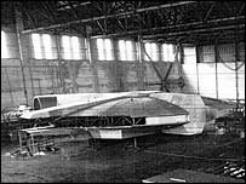
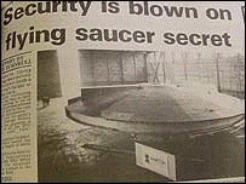
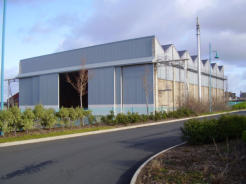


Town's Star Wars History

TOP
HOME
(Amendment, updates and additions) (AJ) Anndra Johnstone
This site is designed, published and hosted by CatsWebCom Community Services © 2018 part of Pembroke Dock Web Project


































